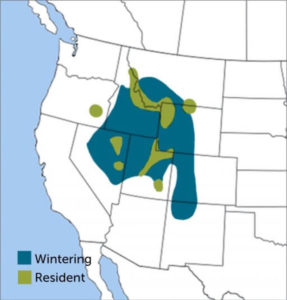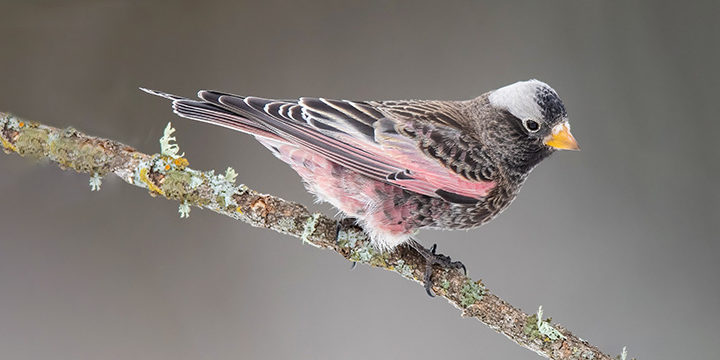Bird of The Week: Black Rosy-Finch
Scientific Name: Leucosticte atrata
Population: 20,000
IUCN Status: Endangered
Trend: Decreasing
Habitat: Alpine peaks, snowfields, and tundra.
About the Black Rosy-Finch
Nesting above where most people live, the Black Rosy-Finch is one of North America’s least-familiar yet most striking songbirds. With his wings splashed in pink and a light gray blaze sweeping his head, the mostly blackish male is a memorable sight.
These birds frequent lofty summits and alpine tundra near a few other high-elevation species, including the American Pipit, Pine Grosbeak, Dark-eyed Junco, and Pine Siskin. Yet they share something with tropical birds including the Palila of Hawai’i.
Divergence
Like the Hawaiian honeycreepers and famed Galápagos finches, North America’s three rosy-finch species are thought to have sprung from one founder species. Recent genetic studies confirmed that while they remain closely related (they were once lumped together as one species), and do interbreed on occasion, the rosy-finches are indeed separate species that likely diverged from populations isolated by glaciation during the last ice age.
Songs and Sounds
The Black Rosy-Finch’s rather nondescript yet resonant call sounds somewhat like vocalizations of the House Sparrow and Evening Grosbeak. The other rosy-finches sound similar. These vocalizations can help birders locate rosy-finch flocks moving across vast open spaces.
Breeding and Feeding
Cliff Notes
In late winter, male Black Rosy-Finches start squabbling and singing, while the birds still rove in flocks. Ornithologists are not sure if pairs bond during this time or after, on the breeding grounds.
Black Rosy-Finch pairs produce one brood per season, during the brief warmth of mid-summer. They usually nest on cliffs, where females choose nest sites protected from the elements and beyond the reach of predators. The nest is usually placed in a cavity, crevice, or other hard-to-reach spot, sheltered by an overhang. There, the female builds a cup nest of grasses, forb stems, and moss, lining it with softer materials, often including fur (such as from Yellow-bellied Marmots or Bighorn Sheep). Small pieces of porcupine quill or some feathers might be included in the cup as well. The female lays three to five white eggs, which she alone incubates for about two weeks. After hatching, the young stay in the nest almost three weeks. During that time, they are brooded by the female and fed by both parents. After they fledge, the young continue to receive food from their parents for a few more weeks.
Secure Storage
Much of the year, Black Rosy-Finches travel in flocks, and where winter ranges overlap, they often associate with Gray-crowned and Brown-capped Rosy-Finches. In winter, these birds are on the constant look-out for seeds (the majority of the diet in winter) and also dead insects released in melting snow or exposed or delivered by wind. They commonly feed on tundra, along snowfields, and around edges of highland lakes. In summer, they catch live insects, during the relatively brief summer period when invertebrate activity peaks.
In addition to a crop (the muscular pouch where birds store excess food before digestion), rosy-finch species also possess special paired sacs beneath the floor of the mouth, a feature found in only one other bird species in North America, the Pine Grosbeak. This extra storage space allows parent rosy-finches to carry extra food, so they can wander farther in their barren surroundings in search of sustenance for their fast-growing nestlings.
Region and Range
 The Black Rosy-Finch nests above the treeline in parts of six mountain states — Montana, Idaho, Wyoming, Utah, and isolated pockets in Nevada and Oregon. In winter, some may remain in nesting areas, while others move downslope, especially after heavy snows. Flocks also disperse south and west — as far south as north-central New Mexico and Arizona and as far west as west-central Nevada and adjacent California. In winter, they often show up in settled open areas, including at feeders.
The Black Rosy-Finch nests above the treeline in parts of six mountain states — Montana, Idaho, Wyoming, Utah, and isolated pockets in Nevada and Oregon. In winter, some may remain in nesting areas, while others move downslope, especially after heavy snows. Flocks also disperse south and west — as far south as north-central New Mexico and Arizona and as far west as west-central Nevada and adjacent California. In winter, they often show up in settled open areas, including at feeders.
Conservation
The Black Rosy-Finch is listed as Endangered, mainly due to grave uncertainty about its future in the face of ongoing climate change. Climate models predict rosy-finches will lose a lot of ground if the climate continues to warm, the birds having to move ever-upslope in the mountains. It’s hard to imagine a bright future for these birds as snow and glaciers recede in many places, yet there may be hope: A recent study of the Brown-capped Rosy-Finch (also an Endangered alpine species ) indicated that species’ population is genetically robust, likely a sign that these birds remain able to adapt to changing micro-climates within the varied conditions present high in the Rockies — as has also been documented in the rabbit-like American Pika that lives in the same or similar habitats.
Ongoing research is critically important for developing strategies to best conserve rosy-finches and their shifting habitats. The remoteness of these birds’ nesting sites hints at the challenges of gauging their status: In their 2016 report, Partners in Flight provided rosy-finch population estimates based on “expert knowledge” rather than Breeding Bird Survey (BBS) data — the basis for most of the report’s estimates for other species. This is because much BBS data is collected along roadsides, far from rosy-finch habitat.
Get Involved
Policies enacted by the U.S. Congress and federal agencies, such as the U.S. Fish and Wildlife Service, have a huge impact on U.S. birds. You can help shape these rules for the better by telling lawmakers to prioritize birds, bird habitat, and bird-friendly measures. To get started, visit ABC’s Action Center.
Living a bird-friendly life can have an immediate impact on the birds around you. Doing so can be as easy as adding native plants to your garden, avoiding pesticides, and keeping cats indoors. To learn more, visit our Bird-Friendly Life page.
American Bird Conservancy and our Migratory Bird Joint Venture partners have improved conservation management on more than 8.5 million acres of U.S. bird habitat — an area larger than the state of Maryland — over the last ten years. This is a monumental undertaking, requiring the support of many, and you can help by making a gift today.
Source: American Bird Conservancy (abcbird.org)
Black Rosy-Finch by Greg Homel, Natural Elements Productions


